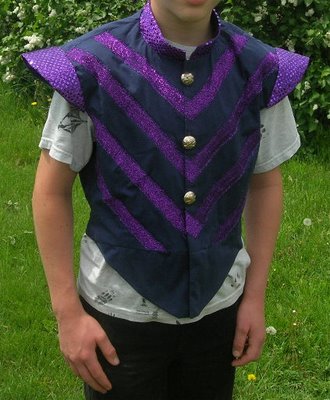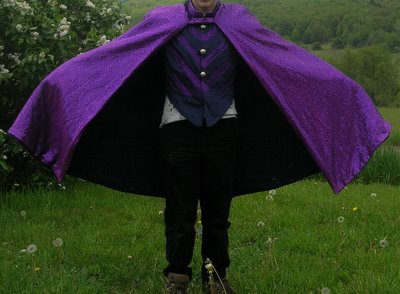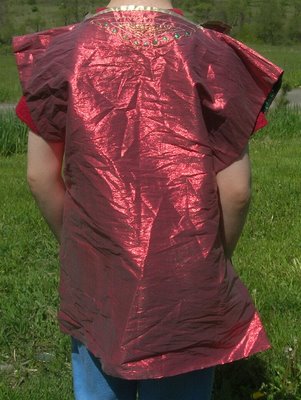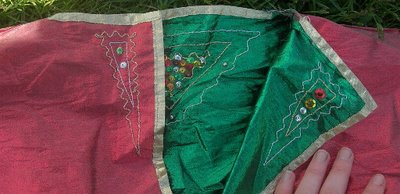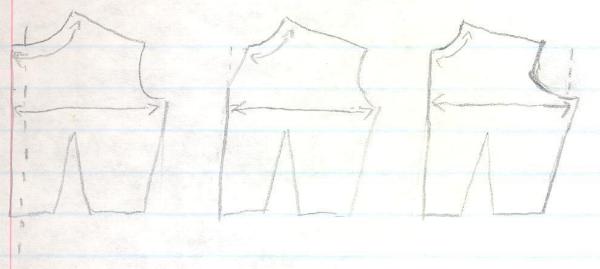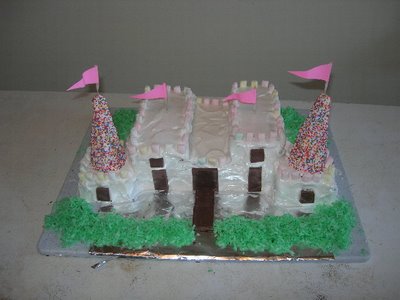Several years ago (I don't remember exactly when, maybe it was like a year and a half ago? Two and a half? It feels like forever), when I was first starting out my dreadful fitting saga, I was getting on the computer to post my fitting problems to the on-line sewing community for help. (Which, I'm sorry to say, wasn't very helpful, in my case.) A few brothers asked what I was doing.
"Trying to get help figuring out how to alter this pattern to fit me."
"Oh." Pause. "Why don't you just buy one that fits?"
"I can't find any that fit!"
"Oh, that's easy!"
"Oh, really?"
"Sure, just get on-line and go to the place where they sell dress patterns for trolls."
"There
isn't a company that makes dress patterns for trolls!"
"Oh, well, dwarves, then. They have dwarf throwing contests in England, don't they? They must have patterns for dwarves."
"I really don't think they go throwing around dwarves while they're wearing
dresses."
(
Brother no. 2 speaks up). "I don't understand why you even need a pattern."
"Because I don't know how to---"
"But it's easy. You just get a burlap sack, and you cut three holes in it. Ta-da! See? Easy."
"Yeah, why don't you just do that?"
At this point, they generally lost interest. Seeing that their utterly brilliant logic was once again being wasted, as pearls before swine, they no longer found it agreeable to pursue the issue any further.
Perhaps, if nothing else, you are wondering why I didn't object to the fact I was being described as a troll. Well, one can't over-look their equally amazing powers of perception--it
was a rather apt description. At barely 5 foot and 1 inch and 135 pounds, the Body Mass Index puts me at 25.5--over weight, but not yet considered "obese". However, as is a common rant against the Body Mass Index, this has a fair amount to do with the fact that I (insert horrified gasping noise here)
lift weights! Short, stocky, more muscular than the average (which isn't saying too much, I'm afraid), hairy, ill-tempered, near-sighted---well, it
does rather describe a troll, doesn't it?
Have I solved all fitting problems? Not yet. (I'm keeping the optimistic "yet" in there, thank you very much.) In the process of trying, though, I've discovered a rather lot about my body shape, and the supposed "average" shape, that I never knew before. Hopefully this post will help other women, weight-lifting or otherwise, to discover what it is that differs from the "normal"---after all, finding the problem is the first step to finding the cure, right? Besides, I'll end the post with "Fitting solutions for these problems--coming soon!"--and up-date the post in another, oh, thirty-five years. If you can't swallow any of that, then I will have to put a in a sub-plot, called "
Why on earth isn't there a pattern company catering to trolls so I wouldn't have to go through all of this work just to get something that fits me relatively decently?" and we'll call the whole thing a therapeutic rant. Which usually aren't that much good for the one ranting, but can occasionally put the listeners in near hysterical giggles. (But then, I think that is often more because of my facial expressions than my actual choice of words, so perhaps you all are missing out on the best part.)
We shall start with the bodice front. Apparently, most pattern drafters think that the typical women has spent most of her life lying flat on her back with a baby elephant using said average woman's ribcage as a cushion for sitting upon. I can find no other reason to account for the fact that they draft the bodice front as though---well, as though the ribcage has been sat on by a baby elephant for one day too many. Yes, yes, they put darts in, and all that jazz. But the front is drafted to be very wide and shallow, as though one were only two dimensional, and if we all turned sideways no one could see us. The front is wide enough it keeps wanting to slip off the shoulders. At the same time, it doesn't allow enough room at the sides (beneath the arms), causing it too pull and strain at the sides as the rather flat pattern tries to wrap around a rather round rib-cage. This means that the bodice front is simultaneously
too large AND too small!!! How utterly brilliant! I don't think I could have dreamed up anything more sadistic if I tried!
And, as further proof of their brilliance, you can't add more to the sides without messing with the armhole, and if you mess with the armhole, you have to mess with the sleeve---The sleeve! That great accursed thing that no one can understand or properly alter! In one breath-taking move, the pattern drafters have got you cornered. I'm pretty sure they have a little check-list:
#1.
Is the garment too small? Check.
#2.
Is the garment too big? Check.
#3.
Will the Cursed Ones---I mean, Consumers--have to alter the sleeve, regardless of what problem they're trying to fix? Check.
I can just hear them giggling up their sleeves, even now. Someone must have gotten a big raise when they dreamed up this problem.
I'm trying to side-step the whole "sadistic pattern drafters" issue by drafting my own patterns. The problem is that, as they say,
a little bit of knowledge is a dangerous thing. To paraphrase, not knowing what you're doing can get you in a lot of trouble.
For instance, the waist. Where, exactly, is your waist? If you had to mark out, in a straight line, where you waist was, where would you put it? Well, the standard advice from great fitting gurus (who might also be laughing up their sleeves; that is of yet undetermined) is that your waist is (a) where ever your side creases when you bend to the side and (b) where there is the greatest amount of indent on the side of your torso. By both of these criteria, the small bit of knowledge I grasp to, my waist is right exactly after where my ribcage ends. This is where I was putting in all of my attempts at drafting, until someone pointed out with crushing logic that, regardless of what the supposed experts say, putting your waistline there looks stupid (agreed), and the whole point of drafting your own is to get it to look right. So either bring it up a few inches and call it "empire waisted" or down a few inches to where it looks right. Well, duh. I should have realized that.
This means that my waist is at the place where my back bends inward the most, running right along the top of my hip bones (not the joint, the
ischium). This makes complete sense; that's where I always put my waistbands anyway. I don't supposed I would have ever considered putting it higher, if I hadn't been told that my waist was where I bent at the side, where I was most indented.
This brings me to my second great mystery, moving from the bodice front to the skirt front. Why, why, why do they put darts in skirt fronts? Darts point to a bump. Where is there a bump
below my waist? If I put my waistline up high at the end of my rib-cage, then I suppose I get a bit of a rise. But a careful scrutiny of a fitting shell pattern showed that the waistline did indeed fall at the top of the hip bones,
not the end of the rib-cage. They showed, and all the gurus claimed, that the "abdomen", the lower torso below the waistline, protrudes. This flabbergasted me.
I mean, yes, my waist does protrude a bit. I think I fall within the healthy range of fat for women--18%-20% (as opposed to the 10%-15% for men), and of that percentage, some of it expectedly falls around my belly button, causing me to have a domed belly--wait, did I say fat? Scratch that. I keep forgetting that the word "fat" is now politically incorrect--it's "feminine fluff". And if there's a bit more than might perhaps seem proper, then it is shortened down to "fluff". Remember that, now. (I'm terrible at being politically correct.)
Anyway, the point was, I
don't bulge out
below my waist. My waist is my most protruding point. And I couldn't for the life of me figure out why on earth anyone would. I finally found my answer in, of all places, a weight-lifting book. (Frederic Delavier's
Women's Strength Training Anatomy.) Page 109: "
Ptosis: Inferior displacement of an organ, most often because the structures normally maintaining it have let go. When the abdominal wall lacks tone, it cannot retain the viscera, and the belly collapses and creates a pocket in which the loops of the intestines rest." This weirds me out considerably. I don't like the idea of my guts all falling in a heap. I'd much prefer that they some how all stayed in place, regardless of my muscle condition. Guts just seem like an altogether much too important part of the body to go moving about like that.
I am happy to report that all of my guts are firmly in place. Thank goodness. Does anyone else besides me find it disturbing that this condition is considered the
normal? All the fitting shells have these front darts. How on earth can it be considered normal to have your guts falling out? Though I suppose that perhaps in may be a reason why the "normal" also has a smaller waist measurements--if all of your guts have decided to take up a southern vacation home, I suppose that means they've evacuated from the more northern waist, which I suppose means the waist can collapse inward more, causing this supposedly normal person to have a narrower waist.
What happens when you put in front waist darts and you don't need them?
This. See how the skirt is all poofy in front, even though it's supposed to be a fitted skirt? The darts create a "pocket" of fabric for something that isn't there.
This lady obviously needs the darts. She isn't
fat, but she does bulge out a bit
below the waist.
So, hypothetically speaking, since I don't have a "protruding abdomen", my skirt should fall straight down from my waist, right? Wrong! Here's where that dratted weight-lifting comes in. Whoever the heck it was that decided the "normal" person was someone with a totally atrophied muscular system certainly never includes this as a "fitting problem". It's called--"protruding quadriceps"! This terrible condition happens when you actually
use your muscles, namely the ones on the front of your
thighs. (I'm not talking about "saddle bags", or lumps and bumps on the side of the legs, but the muscle groups on the front of the thighs.) My skirt situation is thus:
(a)
belly domes out with fat--I mean, fluff.(b)
belly slopes back inward, due to the fact that guts are comfortable where they are, and are not currently considering a move to a more southern-ly retirement home.(c)
quadriceps--on both legs--bulge out from (shockingly!) physical exercise. The front circumference measurement across the quadriceps exceeds the front circumference of the waist!!This is a
scandal!! My thighs are bigger than my waist! And it's not like I have a teeny-tiny waist either! And no one tells you how you're supposed to make a skirt when your legs are sticking out further in the front than your waist does! Do you put in darts, pointing toward the muscles in your legs? That would work, I suppose, but it would look awfully weird. And how are you supposed to deal with the whole fact that there is an
indent between waist and thigh? Right where I'm supposed to be taking the abdomen measurement (where my stomach is supposedly sticking out the most), my stomach is sloping inwards. By the time I'm level with my hip joints, there is a definite indent. There is no way to tell what width the skirt should be between waist and protruding quads, so I just have to wing it. (The actual measurement wouldn't help me, because I want the skirt to fall evenly from waist to thighs,
without indenting.)
But this is certainly one reason why I have to wear loose-fitting jeans. My quads usually have to "borrow" fabric from the back of the pant leg, as the "normal" person who wears jeans apparently doesn't put their quads to much use. Or else the jean designers are just as sadistic as the pattern drafters. I'm sure there is a conspiracy in here somewhere.
Moving along, we come to the bodice back. I can't see my back, so it's very hard to make diagnostics. My first clue that something weird was up was that everything seems to strain across my upper back, leading me to wear, um, loose t-shirts. Once the shoulder seams are falling off my shoulders by a few inches, I have enough room to comfortably maneuver without feeling the fabric tighten and constrain across my back. This also means that, in any dressy-type blouses, by the time I get the shirt big enough I'm not in danger of ripping out every back seam the garment has (and perhaps creating a few new ones), the front is as loose as a burlap sack (a
large burlap sack), and the sleeves look like they belong on some supposed primitive pre-human whose knuckles drop down below it's knees. What does that make me? An Incredible Hulk? I mean, Hulkess? I think I'll just stick with troll.
A digital picture of my back proved the fact that I have, an, um, back. And, from all appearances, an un-normal back. The whole "normal means disintegrating muscular system" is making more and more sense all the time. Apparently, it's decidedly
un-normal to have a healthy, well used body. So sue me! I actually use the muscles on my upper back. This, apparently, is another fitting problem.
I also have a bunch of probably-also-abnormal muscles popping up around the back of my neck, making it awfully hard to figure out where the "shoulder seam" is supposed to fall. It also gives me the added "bonus" of making my already short neck look even shorter.
Next comes the skirt back. My version of the saying "No if's, and's, or but's" is "No hips , and a big butt." I am practically straight-up-and-down at the sides. I pin-fitted some Pattern-Ease (translucent interfacing for the purpose of tracing pattern on to) about my hips; the resulting curve wasn't curvy. If I mark my hip joint as point A, and my waist at point B, and draw a straight line connecting the two, the resulting line is at exactly 98 degrees. I am seriously serious. I went and got my sister's protractor and checked. At the point where my hip curve actually curves out the most, it's 1/4 of an inch away from touching line AB. My hips curve out only 1/4 of inch, how's that for un-normal?
My rear, on the other hand, is either full of enough explosive muscle power to take me to the moon, or else is carrying around enough supplies to get me through a particularly brutal 7 year famine. I choose to believe the former, thank you very much.
This pretty well concludes my rant.
Please don't conclude that I think the entire industry ought to switch to drafting to my exact measurements; my rant is more against the ridiculousness of calling any body shape "normal", when they're so obviously all different. It's not truly against the pattern drafters or clothes manufactures, or any body shape, or lack of shape. No doubt, if you have ever struggled with fitting issues, you're thinking something along the lines of, "That's nothing! You should see what I'm up against!" or else, "Just wait until you get old, then you'll really having fitting problems." Quite true, I'm sure. I'll probably be writing some rant entitled:
Why isn't there a pattern company that caters to aging trolls who still haven't figured out how to alter for their fitting problems?

